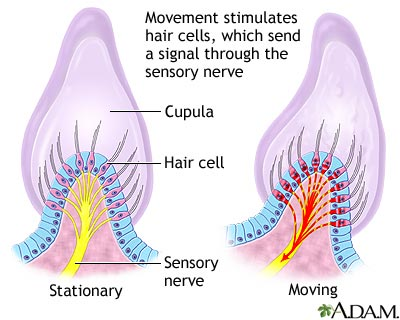Description - images shown at bottom of post
Diagram 1on the left of the image shows a cupula which is stationary. A main sensory nerve comes straight up into a bell-shaped structure which is the membrane lining the inside of the semi-circular canals. It is lined with rectangular cells. Inserted between these cells, at the top third of the bell are hair cells which are all connected to the sensory nerve by peripheral nerves. These sensory cells are more oval in shape with protrusions into the roughly triangular area of the cupula which covers the top third of the bell shape.
Diagram 2 on the right of the image is very similar but shows a cupula and bell-shape bent over to the right as fluid movement in the canals pushes it to one side. The image text states "Movement stimulates hair cells, which send a signal through the sensory nerve" and this is shown on the diagram with red arrows marked from each sensory cell, through peripheral nerves and joining the main sensory nerve.
Comments
Over the last few years I have been working quite intensively with two students with severe visual impairments who are studying neuroscience. Initially I was providing all support but the lecturer decided to employ a PhD student to create models and use the T3 to create tactile slides. This ensured that the students had the best possible access to the diagrams that they were required to be familiar with for their studies.
This meant that I only needed to make a brief description of each image on the slide as the student also had reference to a copy of the image in tactile format or a model if that was more appropriate.
At the start of their courses, I had to describe the images completely and this is what I have chosen to do for this exercise. I have chosen a simple image as the more complex images take pages of text to describe and really are not very useful for the student. Tactile images or models are much more suitable.
I also feel that you need to be very familiar with the material you are describing so that you do not mislead the student and you know which parts of the diagram are important to include.
Another point that I consider important is that it is possible to do a general instruction for a student but it is more effective if it is a description tailored to an individual student as you know the course material that they have already covered and you can use comparisons with which they are familiar. For example I know that one student I work with lost their sight at the age of 7 years, has a good understanding of colour and likes me to include colour into descriptions as it brings it to life for them. Other students would not like this at all!
Yet another point concerning individual descriptions is that the length of the description depends on personal preferences and impairments. One student requires short descriptions as he is also dyslexic and struggles with short term memory problems; another likes complete descriptions in full detail.
I do find it difficult to describe diagrams to students when they have to interpret them for themselves. It is possible but the person describing the image has to ensure they stick to describing shapes and do not include any academic terms - I find this easier if I do not know the subject well. I have had to do this for flow diagrams in computer science and chemistry.
The most difficult part of my job is at the start of the course when the images on slides may not have been transcribed. I am then involved in notetaking everything a lecturer says whilst trying to verbally describe the image they are talking about to the student sitting next to me! Sometimes encouraging the student to chat to the lecturer will result in the lecturer giving a brief description of the image before they go on to point out the salient points but it is still difficult. In some ways it is easier on an online course when the student can take all the time they need to work out the description of an image before beginning to study the text. In a lecture theatre it has to be done so fast that the student often loses track of what is happening and wastes an hour just sitting there before having to go away and start again either on their own or with a support worker. Of course this depends on whether a support worker is available and it can result in a student falling behind after just one lecture and being unable to understand the next lecture.
